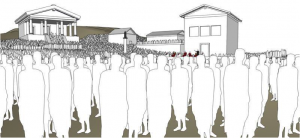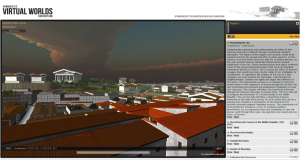RomeLab
Spectacle (based at UCLA; PI: C. Johanson, Consultants: R. Beacham, S. Goldberg, D. Favro)
Overview
Spectacle: Performance on the Ephemeral Stage, set in Rome of the Middle Republic, aims to transform the ephemeral experience of ancient spectacle into a digital object fit for experiential analysis. The project re-assesses current views on the stagecraft of Roman gladiatorial games, dramatic performances and oratorical displays, by, for the first time, studying the three as a cohesive system, each inextricably connected to the spaces and places of the city of Rome during the middle Republic. This study has a twofold goal: 1) To present scientifically-based analyses of the most plausible locations for the staging of and seating for these events 2) To use these reconstructions to argue that the determined mode of viewing and manipulating the imagery of the city supported the persistence of temporary stages and seating spaces for nearly three centuries, long after cities throughout the rest of the Mediterranean had come to rely on purpose-built structures.
Background
Spectacle has received considerable attention in recent years, but its study has at times been marred by deficiencies in method. Consortium collaborator, Richard Beacham, pinpoints the problem: “Spectacle is three-dimensional and sequential, realized by taking place over a period of time, and its place, circumstance, and unfolding fundamentally shape what an audience both expects and experiences.” Ritual parades, political speeches, and religious rites are well described in ancient texts and frequently depicted in art. Yet, most spatial and spectacular analyses attempt to reconstruct the monuments, imagery, actors and audience, which are inherently kinetic and multi-dimensional (changing over space and time), by means of textual description, two-dimensional plans, or hand-drawn sketches and static renderings that offer no means of transparently revealing the connection between hypothetical reconstruction and real-world referent. Imagery can be captivating and convincing, even if marshaled to support an argument that may be lacking when put to a spatial test.
Interactive, three-dimensional models offer a solution, and there are now a growing number of projects that have used computerized reconstructions to visualize Imperial Rome. There have been very few similar attempts to represent the Republican city, and hardly any that make sustained scholarly arguments set within the digital reconstructions.[1] Most reconstruction projects tend to focus on the creation of the digital model informed by scholarship as the ultimate goal.[2] This project uses hypothetical reconstructions instead as digital laboratories both to test the validity of competing reconstructions and to challenge assumptions about how these spaces and places were used.
The Workplan
This project interrogates the spectacular performance spaces of the Middle Republic to ask how and where were Roman plays, orations, and gladiatorial performances staged in the Roman Forum, and how did the setting (or settings) affect the meaning and reception of these events.
The impact of monumental structures on Roman performers and their audiences—what could and could not be seen during their performance, as well as the significance of monumenta memoriae—directly affected the shows when first performed, and the reading and interpretation of the records subsequently examined by scholars. Performance “stages” and “seats” of the mid-Republic were ephemeral: gladiatorial arenas and the stages for plays were, for the first two centuries of their documented existence at Rome, almost always temporary. Extant temple podia, hillsides, and elevated balconies often served as the only dedicated viewing locations. Since there was no canonical venue for spectacle, there cannot be a single reconstruction. Instead, for this project we will create a multiplicity of possible reconstructions, each with internal variables that manipulate stage size, location, audience arrangement, and blocking.
The Ephemeral Stage
The scholarly communis opinio holds that the origin of the Roman amphitheater can be found, not in early stone theaters but instead in elaborate temporary structures erected on military campaigns and in the Roman Forum during the early second century BCE (Before Common Era).[3] It is hypothesized that the Romans would have built enormous wooden structures in the middle of the Roman Forum to accommodate gladiatorial games. The visual evidence adduced—detailed hypothetical plans and seemingly plausible reconstruction drawings—have been so convincing that the conflicting evidence has been inexplicably and surprisingly overlooked. The underlying textual evidence for these temporary arenas as well as the archaeological evidence, spatial limitations of the site itself, and the contextual restrictions placed on any such construction by the social, religious and political use of the Roman Forum all point to another solution, one that requires a far simpler support apparatus and that uses the site of the Forum itself as both performance and “bleacher” area of the games.
The prevailing view is supported by a misreading of text and context, and its proposed reconstruction both blocks critical vantage points indicated in other texts, and ignores the most important element of gladiatorial performance, namely, that up until the middle of the 1st century BCE, the games were performed in conjunction with the funerary celebration of Roman aristocrats. Often overlooked by even those in the field, Gladiators only fought at aristocratic funerals until the time of Caesar. Gladiatorial games and dramatic performances were staged side-by-side, not in monumental amphitheaters, but instead in the civic and religious heart of the city, the open-air market place and municipal hub, the Forum. Any arena constructed within the Forum would have blocked access to the nearby speaker’s platform, where the funeral eulogy was performed; occupying space normally allocated to viewing areas for the eulogy, it would have interfered with critical locations for viewing arena spectacle, specifically mentioned in sources of the first century BCE.
Figure 1. The Funeral Eulogy
An alternate reading of the primary texts indicates that, rather than construct elaborate seating environments, the Romans were accustomed to ad hoc viewing spaces, where the arena was defined by nothing more than simple stanchions (cancelli). Seats and standing-room-only viewing spaces were to be found, not in purpose-built bleachers, but on the steps of temples and balconies overlooking the forum plaza and on the gentle slope leading down to the forum from the adjacent Capitoline Hill. Because the event needed to be arranged quickly due to obvious temporal constraints of a funeral, and since it needed to be vacated equally quickly, one must imagine a performance more similar to a Victorian era bout of bare knuckle boxing—often performed without seating facilities but still reportedly attended at times by more than 15000 spectators—than the later arena performances made so popular in the monumental amphitheaters of the principate.
We will combat the convincing but ultimately erroneous visual evidence of the current argument surrounding the reconstruction of the early amphitheater through a visual analysis built from, tested in, and disseminated through the Consortium’s Virtual World. The project will first scientifically test and disprove the current hypothesis by means of a 3D computer model. First by representing the large-scale, wooden amphitheater alongside the other competing elements, e.g., the speaker’s platform that supported the funeral eulogy and the temporary stages for plays. It will then use a scientifically accurate geo-referenced 3D computer model of the archaeological evidence of the surrounding site as a controlled testing environment into which the proposed arena systems will be inserted.
Outcomes
The project will produce the open-world experience of the digital Roman Forum set in the second century BCE and three interlocking “articles,” output in three distinct formats: an article submitted to a peer-reviewed journal in a traditionally defined discipline; a draft “article” set within the virtual world platform of the Consortium; a third, mirror-copy of the virtual world argument, output through the UCLA HyperCities environment . 1) The results of the research along with images derived from the virtual world will be submitted to the Journal of Roman Archaeology, the Journal of Roman Studies, or similar academic journals. 2) The primary and most effective means of disseminating the argument, however, will be through the Virtual World infrastructure of the Consortium. In the prototype (See Fig. 2 and http://hvwc-server.ats.ucla.edu), the text of the article appears as a linear narrative that runs along the right-hand side of the screen. When clicked, each paragraph walks the reader’s avatar to an associated view within the 3D space. These paragraphs and the underlying Virtual World system are united through shared geographic coordinates—the articles are simply XML (Extensible Markup Language) feeds, specifically KML (Keyhole Mark-up Language) and GML (Geographic Markup Language). KML and GML are standard XML based geographic encoding standards sanctioned by the Open Geospatial Consortium (http://www.opengeospatial.org/).[4] 3) The Virtual World platform to be developed by the Consortium is, in fact, a first step toward the creation of an avatar-based, 3D exploration of geo-spatial data. Therefore, the same narrative viewable in the platform can also be viewed in other geo-aware browsers. Because of the inherent interoperability in geo-based content, as a proof-of-concept, the draft geo-temporal “article” will be concurrently released within UCLA’s HyperCities, a geo-temporal content aggregation and dissemination platform (http://www.hypercities.com). During the development of the virtual world articles, a collaboration with innovative print/digital journals such as the Journal for the Society of Architectural Historians (JSAH) will be pursued in order to explore the possibility of applying a professional organization’s peer-review process to the Virtual World article.
Three-dimensional Digital Content
The project builds on a robust database of previously constructed digital models. The massing models of unique buildings in the mid-republican Roman Forum were constructed in SketchUp (.skp) and are available as Collada (.dae) files. Digital models of the Republican Forum 3rd–1st centuries BCE along with hypothetical context for the entire city have been “grown” through procedural modeling techniques using ESRI CityEngine.[5] (See Fig. 2) The procedural modeling framework will be developed to reflect the changing architectural styles of the 3rd-2nd centuries BC and will be expanded to include massing models of the Palatine Hill and surrounding vantage points. Models of temporary theatrical stages previously developed at Consortium partner, King’s Visualization Lab, will be added to the Unity environment. In addition, individual, moveable components representing avatars, temporary stages, temporary seating, and statuary, will be created. Using a variety of file translation methods, the old databases and the new constructions will be merged to form the core content for the digital laboratory. A subset of this digital content will be translated into Collada file format, exported as KML and published in the HyperCities Geotemporal Publication environment to ensure maximum visibility.
Figure 2: A view toward the Capitoline Hill of the procedurally generated cityscape. The surrounding interface is a working prototype for the Humanities Virtual World Consortium. A running narrative on the right takes the “reader” from view to view. The narrative is generated from KML created by HyperCities.


